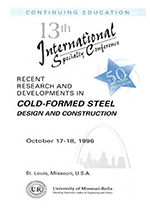Session Dates
17 Oct 1996
Abstract
In both Australia and the U.S.A., the design procedure for purlins under wind uplift loading is based on the use of reduction factors (R-factors), which allow for the flexural-torsional or nonlinear twisting behaviour of purlins with screw-fastened sheeting. To date, all R-factors have been determined by testing. However, in the future it may be more efficient to obtain R-factors from numerical models to minimise testing. This paper shows how a numerical model of the twisting behaviour of channel and Z-section purlins can be used to generate R-factors. Comparisons between experimentally determined and numerically based R-factors are made.
Department(s)
Civil, Architectural and Environmental Engineering
Research Center/Lab(s)
Wei-Wen Yu Center for Cold-Formed Steel Structures
Meeting Name
13th International Specialty Conference on Cold-Formed Steel Structures
Publisher
University of Missouri--Rolla
Document Version
Final Version
Rights
© 1996 University of Missouri--Rolla, All rights reserved.
Document Type
Article - Conference proceedings
File Type
text
Language
English
Recommended Citation
Rousch, Catherine J. and Hancock, Gregory J., "Determination of Purlin R-factors Using a Non-linear Analysis" (1996). CCFSS Proceedings of International Specialty Conference on Cold-Formed Steel Structures (1971 - 2018). 4.
https://scholarsmine.mst.edu/isccss/13iccfss/13iccfss-session3/4
Determination of Purlin R-factors Using a Non-linear Analysis
In both Australia and the U.S.A., the design procedure for purlins under wind uplift loading is based on the use of reduction factors (R-factors), which allow for the flexural-torsional or nonlinear twisting behaviour of purlins with screw-fastened sheeting. To date, all R-factors have been determined by testing. However, in the future it may be more efficient to obtain R-factors from numerical models to minimise testing. This paper shows how a numerical model of the twisting behaviour of channel and Z-section purlins can be used to generate R-factors. Comparisons between experimentally determined and numerically based R-factors are made.



